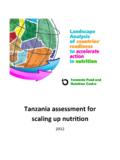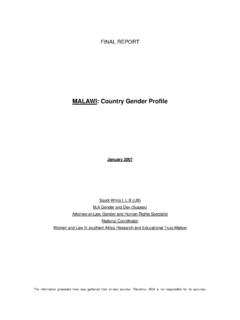Transcription of Consequences of micronutrient deficiencies in Africa …
1 Consequences of micronutrientdeficiencies in Africa Now is the time to Consequences of micronutrientdeficiencies in Africa Now is the time to Now is the time to act!!Now is the time to act!!Today s presentation1. Under nutrition, micronutrient deficiency and its impact on child survival and and Continental trends in addressing and Continental trends in addressing micronutrient Deficiency3. Food Fortification and its role in reducing MNDN utritional StatusHealth DietManifestationsImmediateCausesConcept ual Framework of UndernutritionHuman, Economic, andInstitutional ResourcesHouseholdFood SecurityPotential ResourcesEcological ConditionsCare of Motherand ChildEnviron. Health,Hygiene & SanitationPolitical and Ideological StructureRootCausesUnderlyingCausesAdapt ed from UNICEFC auses of Child Mortality4195 Million under-fives in the developingworld are stunted >90% of the developing world s stunted children live in Africa and Asia and 80% of them live in 24 countries5 And beyond is also important for.
2 Physical growth Behavioral development, cognitive functionfunction School attendance, performance Ultimate income-generating capacity, Economic development Risk of non-communicable diseases6 Further Global Nutrition Series-February 2008-Analyzed data from five long-standing prospective cohort studies -Noted that indices of maternal and child undernutrition (maternal height, birthweight, 7undernutrition (maternal height, birthweight, intrauterine growth restriction, and weight, height, and body-mass index at 2 years were related to adult outcomes (height, schooling, income or assets, offspring birthweight, body-mass index, glucose concentrations, blood pressure). -Undernutrition was strongly associated, with shorter adult height, less schooling, reduced economic productivity, and for women lower offspring important MND?- Vitamin A deficiency, iron deficiency, and iodine deficiency disorders- Followed closely by other nutrients, such as zinc, calcium, riboflavin, vitamin B6 and B12, and folateChildren and women of reproductive age are especially vulnerable: Higher physiological needs Unfavorable intrahousehold food allocation patterns Poor quantity, frequency, and quality of complementary foods and inadequate and breastfeeding practices8 Micronutrients?))
3 MicronutrientEffect on HealthVitamin A deficiency Growth faltering , impaired motor and cognitive development, vision, and immune system In children estimated to account for approximately 20-24% of child mortality from measles, diarrhea, and malaria, and 20% of all-cause maternal mortality Extreme deficiency leads to blindness and deathIron DeficiencyMost prevalent nutrient deficiency estimated to affect 4 to 5 billion people. In young children , iron deficiency may impair growth, cognitive development, and immune function. In school-aged children , it can affect school performance, estimated to affect 4 to 5 billion people. In school-aged children , it can affect school performance, in adults it may lower work capacity. Iron deficiency anemia is responsible for tens of thousands of maternal deaths each yearIodine DeficiencyThe loss of human intellectual, physical, and social potential caused by iodine deficiency has been enormous. Particularly damaging during pregnancy, as it retards fetal development, Results in a range of intellectual, motor, and hearing deficits in the offspring Zinc DeficiencyEven mild zinc deficiency could result in estimated 176,000 diarrhea deaths, 406,000 pneumonia deaths, and207,000 malaria deaths worldwide In WRA, may result in pregnancy complications, low birth weight, impaired immune function, maternal and infant mortality and morbidity, In children , growth faltering in infancy and childhood Reduced immune function and more susceptible to a variety of infectious diseases 9 Global deaths and disability-adjusted life-years (DALY) in children < 5 yrs attributed to micronutrient deficienciesDeficiencyDeath% of death in children < 5yrDisease burden (1000 DALYs)
4 % of DALYs in children < 5yr< 5yr< 5yrVitamin A667, , , , , , , , et al, Lancet 2008 Copenhagen Consensus 2008 Identifies nutrition interventions among the most cost effective interventions to advance global welfare if $75 billion of resources were available over a four year period:#1: micronutrient supplements for children (Vitamin A & zinc)#3: micronutrient fortification (iron and salt 11#3: micronutrient fortification (iron and salt iodisation)# 5: Biofortification#6: Deworming & other nutrition programs in schools#9: Community based nutrition promotionOut of a total of 30 Vit A12 MND- Iron13 MND- Iron14 MND- Iodine15 Key Interventions for Elimination ofMicronutrient deficiencies Supplementation Single multiple or micronutrients Fortification Foods for the general population (flour, oil, salt, sugar) Fortification of specific foods, incl home-fortification Promotion of optimal feeding & diversified diets Optimal breastfeeding (early BF initiation, EXBF for 6 months, continued BF for up to 2 years) micronutrient -rich foods, including animal source foods Public health measures Infection control Hygiene limited success18 Addressing Anaemia in pregnant women remains a severe Public health problem- (Uganda,Tanzania, Kenya, Madagascar, Malawi, Burundi & Zambia) While it can be prevented and treated by iron folic acid(IFA))
5 Supplementation, access remains a concern -with only Burundi and Zambia having the highest coverage among the12 ESA countries at 50 & 44 % having the highest coverage among the12 ESA countries at 50 & 44 % respectively. With limited reach of IFA supplementation countries need to seriously consider alternative strategies including promotion of diversified diet and fortification. Countries could draw on existing experiences of mandatory large scale wheat and maize flour in partners countries and accelerate action19 Universal Salt Three of the 12 countries-Burundi , Kenya and Uganda have achieved the Universal Salt Iodisation Another 3 countries are nearing the USI goal-Rwanda, Zambia and Madagascar Household access to iodised salt is below 50 percent in remaining countries-Tanzania, Mozambique and Ethiopia, requiring urgent priority attentionWhy do we need to fortify?- Example Tanzania Vitamin and mineral deficiencies are severe problems in Tanzania causing a heavy burden of disease and disability as well as exacting a heavy economic tollwell as exacting a heavy economic tollWhy do we need to fortify?
6 During the processing of grains and oil, essential vitamins and minerals are lost, making these foods less nutritious after processing Fortification replaces nutrients lost during the processing of foods 80%100%120%Nutrient retentionLoss of vitamins and minerals during milling of wheatthe processing of foods and can add other vitamins and minerals and can that way also be used to address micronutrient deficiencies0%20%40%60%100%95%87%80%75%6 6%Degree of millingNutrient retentionThiaminRiboflavinVit. B6 FolateIronNiacinConclusion In most of the regions, diets are deficient in vitamin A, iron , zinc and Iodine- These deficiencies are of Public health concern Everyday bulky foods do not offer the density of essential nutrients that people need, particularly during 23essential nutrients that people need, particularly during periods of high physiological needs and acute vulnerability Large scale micronutrient malnutrition and its Consequences call for immediate and large-scale action Fortifying major food vehicles -wheat or maize flour, sugar and oil is highly most cost-effective strategy to address micronutrient malnutritionThank you!
7 UNICEF, WB/Tanzania







